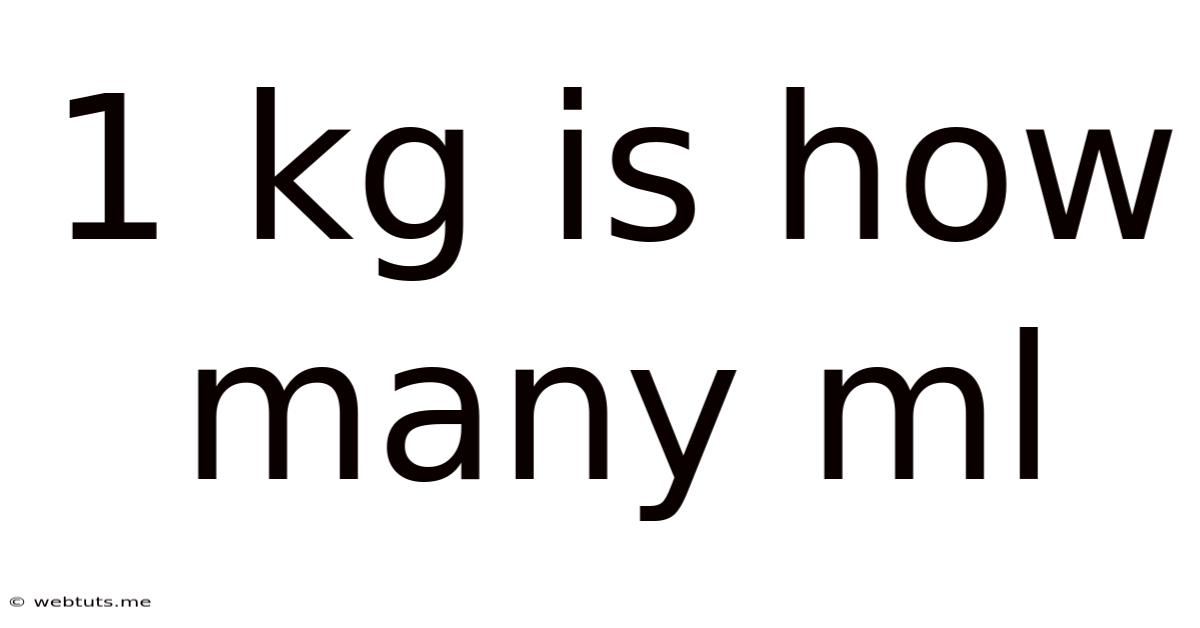1 Kg Is How Many Ml
Webtuts
May 12, 2025 · 4 min read

Table of Contents
1 Kg is How Many Ml? Understanding Mass, Volume, and Density
The question "1 kg is how many ml?" doesn't have a straightforward answer. It's a common misconception to equate mass (kilograms, kg) and volume (milliliters, ml). The relationship between the two depends entirely on the density of the substance being measured. Density is the mass per unit volume, typically expressed in grams per milliliter (g/ml) or kilograms per liter (kg/L). To understand this, let's delve into the concepts of mass, volume, and density, and then explore how they relate to converting kilograms to milliliters.
Understanding Mass, Volume, and Density
-
Mass: Mass is the amount of matter in an object. It's a fundamental property that remains constant regardless of location or gravitational pull. We measure mass in kilograms (kg), grams (g), milligrams (mg), etc.
-
Volume: Volume is the amount of space an object occupies. It's a measure of three-dimensional space. We measure volume in liters (L), milliliters (ml), cubic centimeters (cc or cm³), etc. One milliliter is equal to one cubic centimeter.
-
Density: Density is the crucial link between mass and volume. It's defined as the mass of a substance per unit volume. The formula for density is:
Density (ρ) = Mass (m) / Volume (V)
Therefore, if you know the mass and density of a substance, you can calculate its volume. Conversely, if you know the volume and density, you can calculate the mass.
Why You Can't Directly Convert Kg to Ml
The key takeaway is that you cannot directly convert kilograms to milliliters without knowing the density of the substance. One kilogram of feathers will occupy a much larger volume than one kilogram of lead, even though their masses are identical. This is because lead is significantly denser than feathers.
Calculating Volume from Mass and Density
To find the volume (in ml) of a substance given its mass (in kg), you need to follow these steps:
-
Convert kilograms to grams: Since density is often expressed in g/ml, convert the mass from kilograms to grams. There are 1000 grams in 1 kilogram.
-
Determine the density: Find the density of the substance you're working with. You can often find this information in a reference table or online database. Remember, density varies with temperature and pressure, so ensure you're using the density value appropriate for the conditions.
-
Apply the density formula: Use the rearranged formula to solve for volume:
Volume (V) = Mass (m) / Density (ρ)
-
Convert to milliliters: The result will likely be in cubic centimeters (cm³). Since 1 cm³ = 1 ml, the volume is also expressed in milliliters.
Examples of Calculating Volume
Let's look at a few examples to illustrate the process:
Example 1: Water
The density of water is approximately 1 g/ml (or 1 kg/L) at 4°C. Let's calculate the volume of 1 kg of water:
-
Mass in grams: 1 kg * 1000 g/kg = 1000 g
-
Density: 1 g/ml
-
Volume: 1000 g / (1 g/ml) = 1000 ml
Therefore, 1 kg of water occupies a volume of 1000 ml (or 1 liter).
Example 2: Mercury
Mercury is much denser than water. Its density is approximately 13.6 g/ml. Let's find the volume of 1 kg of mercury:
-
Mass in grams: 1 kg * 1000 g/kg = 1000 g
-
Density: 13.6 g/ml
-
Volume: 1000 g / (13.6 g/ml) ≈ 73.5 ml
So, 1 kg of mercury occupies a volume of approximately 73.5 ml. This highlights the significant difference in volume occupied by the same mass of substances with differing densities.
Example 3: Aluminum
Aluminum has a density of approximately 2.7 g/ml. Let's calculate the volume of 1 kg of aluminum:
-
Mass in grams: 1 kg * 1000 g/kg = 1000 g
-
Density: 2.7 g/ml
-
Volume: 1000 g / (2.7 g/ml) ≈ 370.4 ml
Therefore, 1 kg of aluminum occupies approximately 370.4 ml.
Density Tables and Resources
To perform these calculations accurately, you'll need to find the density of the specific substance you are interested in. Numerous online resources and scientific handbooks provide density tables for a wide range of materials. Always ensure the density value you use is consistent with the temperature and pressure conditions of your substance.
Practical Applications
Understanding the relationship between mass, volume, and density has many practical applications across various fields, including:
-
Chemistry: Calculating concentrations of solutions, determining the molarity of substances.
-
Physics: Calculating buoyant forces, understanding fluid dynamics.
-
Engineering: Designing structures, ensuring appropriate material selection based on strength and weight requirements.
-
Everyday Life: Understanding why different materials occupy different spaces even when they have the same mass.
Conclusion: Density is Key
In conclusion, the question "1 kg is how many ml?" can't be answered without knowing the density of the material. The relationship between mass and volume is directly proportional to density. By understanding the concept of density and using the appropriate formula, you can accurately determine the volume of a substance given its mass, and vice versa. This understanding is crucial in various scientific, engineering, and everyday applications. Remember to always consult reliable sources for density values and consider the conditions under which the measurements are taken.
Latest Posts
Latest Posts
-
How To Add Feet And Inches
May 12, 2025
-
How Many Days Since July 1 2024
May 12, 2025
-
How Many Milligrams In A Pint
May 12, 2025
-
How Many Days Is 3 000 Hours
May 12, 2025
-
How Many Millimeters Is A Tablespoon
May 12, 2025
Related Post
Thank you for visiting our website which covers about 1 Kg Is How Many Ml . We hope the information provided has been useful to you. Feel free to contact us if you have any questions or need further assistance. See you next time and don't miss to bookmark.